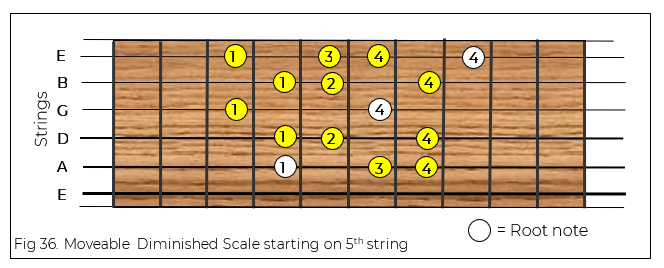The diminished scale contains a flat 3rd note (minor 3rd), a flat 5th note, and a double flat 7th note (compared to the major scale), so the step pattern is:
| tone | semitone | (b3rd) | tone | semitone | (b5th) | tone | semitone | (bb7th) | 1+1/2tone | ||||||
| A | ^ | B | ^ | C | ^ | D | ^ | Eb | ^ | F | ^ | Gb | ^ | A | |
| Frets: | 2 | 1 | 2 | 1 | 2 | 1 | 3 |
Listen:
FINGERING FOR ROOT NOTE ON 5TH STRING:
This pattern can be used when the root note of the natural minor scale falls anywhere on the 5th string.

FINGERING FOR ROOT NOTE ON 6TH STRING:
This pattern can be used when the root note of the natural minor scale falls anywhere on the 6th string.

This is a useful scale to know when changing keys in lead work. The diminished scale has a unique property in that the root, b3rd, b5th and bb7th will share the same notes across the four keys that these notes contain, for example:
| Diminished scale | root | b3rd | b5th | bb7th |
| Key of A | A | C | Eb | Gb |
| Key of C | C | Eb | Gb | A |
| Key of Eb | Eb | Gb | A | C |
| Key of Gb | Gb | A | C | Eb |
Therefore only 3 diminished scales are needed to cover all twelve keys.